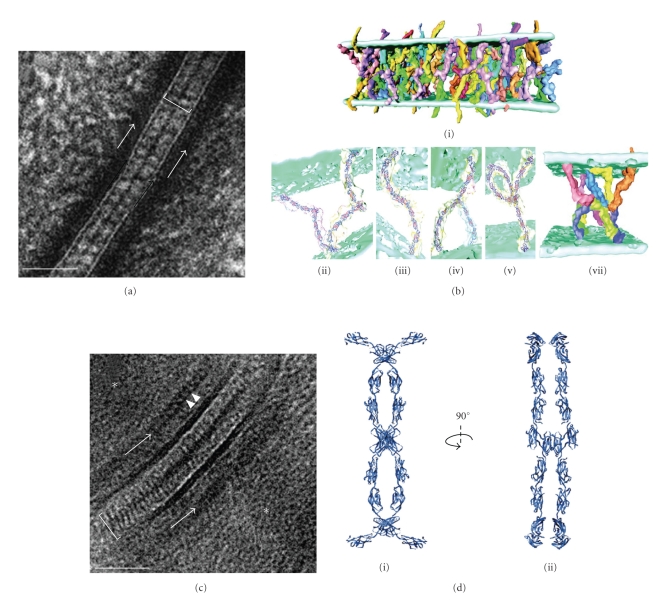Figure 4.
Two models of desmosomal cadherin associations generated from two methods of preparation. A single TEM projection of a newborn mouse epidermis desmosome preserved by high pressure freezing followed by freeze substitution (a). The dense midline is visible bisecting the extracellular core domain (ECD) (white line). Cadherins spanning the extracellular space are separated in an irregular nonsymetrical fashion. A model of cadherin association generated from a dual axis tomogram of newborn mouse epidermis (b i) preserved as in a. C-cadherin crystal structure has been traced onto densities in the ECD believed to be cadherins. The model displays the irregularity of cadherin associations however a dense mid-line is created by tip-to-tip association. The arrangement of cadherins differs to that of the strand dimer model. Three distinct geometries were found resembling the letters W (b ii), S (b iii), and the greek letter λ (b iv). Trans interactions mostly occurred in W and S whereas with λ, cis interactions mostly with S occurred if a third molecule was added (b v). An addition of a third molecule in cis could form a network in associations between up to 6 molecules (b vi). A single TEM projection of a desmosome from vitrified human epidermis processed by cryoelectron microscopy of vitreous sections (c). Densely packed and periodically arranged cadherins can be seen spanning the extracellular space in a straight manner (white line) and associating to form a dense mid-line. A model of cadherin association generated from a single axis tomogram of vitrified human epidermis processed as in c (d). The ribbon representation of the cadherin association model shows a periodic arrangement of curved cadherin densities that are organized with alternating trans and cis associations tip-to-tip. Two distinct geometries were visible in the model. The W shape formed the trans interactions (see d i) whereas the V-shape formed cis interactions resulting in a highly packed regular zipper-like organization. The organization is better visualized when then model is rotated at 90° from d i, revealing two trans interactions and one cis interaction (d ii). Images 4 B modified from [21] reprinted with permission from AAAS. Images 4 a & c modified from, [65] reprinted with permission from Elsevier, and Images 4D from [22] by permission from Macmillan Publishers Ltd. Scale bars 50 nm.

